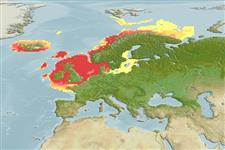Common names from other countries
Environment: milieu / climate zone / depth range / distribution range
Écologie
marin démersal; profondeur 0 - 270 m (Ref. 58496). Temperate; 4°C - 8°C; 77°N - 43°N, 28°W - 46°E
Northeast Atlantic: English Channel to Finmarken and Murman coasts and White Sea, also the Shetlands, the Faroes and southern and southwestern coasts of Iceland; southern part of Baltic.
Taille / Poids / Âge
Maturity: Lm ? range ? - ? cm
Max length : 21.0 cm TL mâle / non sexé; (Ref. 4700); common length : 14.0 cm TL mâle / non sexé; (Ref. 4700); âge max. reporté: 3.00 années (Ref. 722)
Épines dorsales (Total) : 5 - 6; Rayons mous dorsaux (Total) : 6 - 8; Rayons mous anaux: 5 - 7. Unpaired breast row of plates absent, but paired plate rows cover whole breast. Snout with a pair of strong spiny hooks; numerous barbels on branchiostegal membranes. Dorsal plates 31-34 (Ref. 232). Spiny and soft dorsal fins almost fused. No spines on the hind part of the head (Ref. 35388).
Inhabits inshore waters, deeper waters in winter in Skaggerak, preferring sandy bottoms, rarely with stones. Maximum depth reported at 270 m (Ref. 28197). Temp. range: 4.0-8.0 °C. Feeds on bottom crustaceans and polychaetes. Matures after about 1 year; a few spawning in the second year (Ref. 722). The eggs are laid in seaweed (Ref. 9900). Spawns in February - April, female laying 2,500-3,000 yellow eggs with a diameter of 2 mm. Period of development is very long and 6-8 mm long pelagic larvae hatch after 10-11 months (Ref. 35388).
Ehrenbaum, E., 1936. Naturgeschichte und wirtschaftliche Bedeutung der Seefische Nordeuropas. Handb. Seefisch. Nordeurop. 2:337 p. (Ref. 40)
Statut dans la liste rouge de l'IUCN (Ref. 130435)
CITES (Ref. 128078)
Not Evaluated
Menace pour l'homme
Harmless
Utilisations par l'homme
Pêcheries: sans intérêt; Aquarium: Aquariums publics
Outils
Articles particuliers
Télécharger en XML
Sources Internet
Estimates based on models
Preferred temperature (Ref.
115969): 7 - 11.7, mean 9.2 (based on 442 cells).
Phylogenetic diversity index (Ref.
82804): PD
50 = 1.0000 [Uniqueness, from 0.5 = low to 2.0 = high].
Bayesian length-weight: a=0.01023 (0.00397 - 0.02640), b=2.99 (2.77 - 3.21), in cm Total Length, based on LWR estimates for this (Sub)family-body shape (Ref.
93245).
Niveau trophique (Ref.
69278): 3.4 ±0.3 se; based on diet studies.
Résilience (Ref.
120179): Milieu, temps minimum de doublement de population : 1,4 à 4,4 années (K=0.47; tm=1-4; tmax=3; Fec=2,400).
Fishing Vulnerability (Ref.
59153): Low to moderate vulnerability (26 of 100).
